#8: Horse Manure Fake News
Ed Jefferson is attempting to visit every Mews in Greater London. This week: low quality poultry shows, bench theft mysteries, and obscene national anthems, but first…
I do not especially like horses. This may be because as a small, fairly cowardly, child, I was once placed on top of a horse, presumably with the intention that I would ride it - I immediately had a very powerful sense that I wanted to be anywhere else other than on top of the horse and demanded to be returned to the ground.

Luckily for me, I live in 2024, so horses are not a huge issue. I had summer jobs at Goodwood Racecourse as a teenager, once worked in a central London pub next to some stables1, and now see horses wandering past our flat to or from the local riding centre most days - the rural idyll of a council estate in Zone 4, but even in these instances I did and do not have to have any personal dealings with horse. Little more than a century ago, this might not have been the case.
There doesn’t seem to be any kind of thorough horse census, but there cannot be more than a few thousand in the capital these days2 - but at the turn of the 20th century, there were somewhere in the region of 300-400,000 horses in the capital, pulling more or less everything that needed to be pulled - at one point something like 25,000 of them were being used to pull the earliest version of the city’s buses (see image above).
The sheer number of horses presented certain logistical difficulties - whilst horses don’t produce the same kinds of emissions motor vehicles do, as anyone who lives near a riding centre can tell you they definitely do… emit stuff. About 50 lbs worth a day, apparently.
That adds up to quite a lot of manure, and eventually led to the “Great Horse Manure Crisis” - the volume having reached the point where The Times was predicting that within 50 years every street in the city would be “buried under nine feet of manure”. With similar problems arising in cities around the world, eventually an international conference was held on matter - only for the problem to prove so intractable that proceedings disbanded a week earlier than intended, attendees gloomily going home to await their horse poo doom.
Or so a lot of not very well researched “Isn’t history crazy?” websites, blog posts and business mindset LinkedIn articles would tell you, anyway - stick “The Great Horse Manure Crisis of 1894” into Google and you will get thousands of results, almost all of them presenting it as a sort of parable: in the 1890s all the so-called experts were trying and failing to solve the problem of horse manure, but within decades the problem disappeared because tech entrepreneurs invented the motor vehicle! The ‘lesson’ here being that you cannot necessarily extrapolate solutions to your current problems from said problems - you may need disruptive innovation! London didn’t get buried in manure, so we can just presume that some similar bit of tech will come along and save us from climate change, say.
The main problem with this is, that as far as anyone who has looked into can tell, there was no Great Horse Manure Crisis of 1894. That prediction from The Times? Even the newspaper itself could not substantiate that it ever printed such a thing. There’s no evidence of the abandoned conference (which would predate the first recorded urban planning conferences by several years anyway), and in cities where horse manure did become a problem it was typically solved by fairly boring municipal things like ‘regulation’ and ‘employing people to clean the streets’ long before motor vehicles became ubiquitous.
It is not 100% clear where this story arose, but the earliest mention on the internet seems to be a 2004 blog post published by the Foundation for Economic Education, a libertarian think tank, using it to make the argument that the solution to more or less every problem is ‘personal freedom’. Possibly this extends to: if you can’t find an apt historical analogy for your stupid point because it is stupid and you are a stupid baby, you could use your personal freedom to just make one up. I couldn’t possibly say.
This isn't to say there's nothing interesting about the relatively sudden transition that happened in the early 20th century - if you dig into the history of Mewses, say, you find they were still being constructed in original horse-housing form even as the changes that would make that unnecessary were starting to happen. A city once, at least in part, shaped by horses was reshaped by the motor car within the course of a human lifetime (given the right human) - on a small scale (some) Mewses became garages, on the largest scale dual carriageways ripped their way through parts of London.3
Frequently the default assumption is almost that the city is there to serve the car as though it is an unassailable good, and that any attempt to impede the driver should be treated with suspicion4.
But the status quo is until it isn't - in Utrecht in the Netherlands a centuries-old canal was turned into a motorway, but it turned out that was a 40 year blip, and the canal is back. Paris has banned cars from the banks of the Seine. There were 400,000 horses in London, then there weren't. Things change in once unimaginable ways, but change doesn't have to mean unrestrained adoption of whatever the tech bros want to sell next, or that urban planners should give up and leave it to the free market.
The other lesson here of course is that the phrase “The Great Horse Manure Crisis of 1894” is in itself more appealing than any of the various attempts people have made at debunking the story. Probably YOU will read this and almost immediately forget all the other information other than the ‘fact’ that there was a Great Horse Manure Crisis of 1894 and then tell someone else about it because YOU love spreading FAKE NEWS.
Anyway, I don’t especially like horses but when they put me on one when I was a small child I wasn’t scared and immediately rode it really well, and they said I was the best at riding horses, and I only don’t do it now so as not embarrass all the other less good horse riders.
MEWSES VISITED THIS WEEK
#71 Malton Mews, Kensington and Chelsea, W10
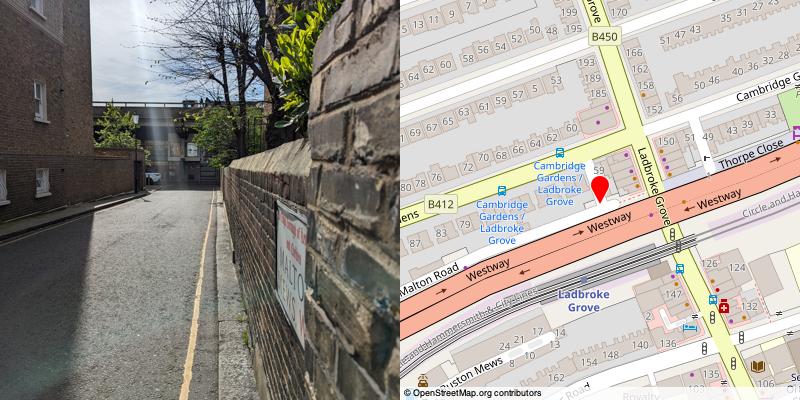
This was named Oxford Mews until the 1930s, when London County Council renamed it. This solved a curious anomaly wherein Oxford Mews ran off Cambridge Gardens and not Oxford Gardens one street up - though it was part of a wider effort to simplify and deduplicate street names across the capital, there’s no extant Oxford Mews in the former LCC boundaries, so maybe someone pedantic slipped it past the authorities.
#72 Railway Mews, Kensington and Chelsea, W10
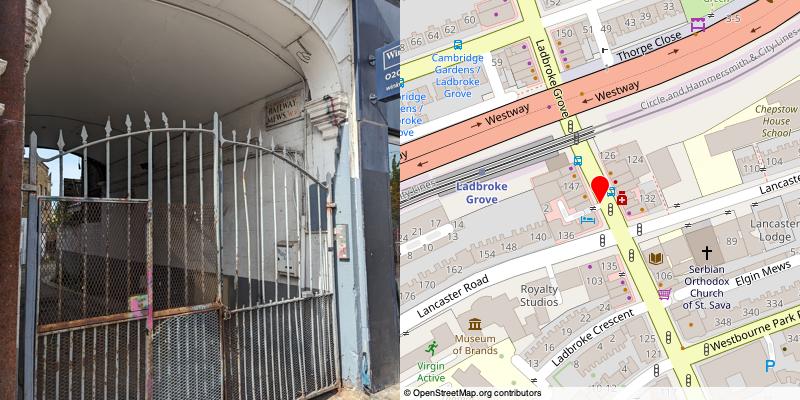
Confusingly, home to a car garage.
#73 Elgin Mews, Kensington and Chelsea, W11

Named after the nearby Elgin pub, itself named for the Earl of Elgin what nicked the marbles from Greece: an excellent example of how sometimes your name going down in history just means generations of people get to find out that you were a twat.
In the 1990s the Mews was a crime hotspot, with newspapers at the time detailing problems caused by “dogs and drunks”, as well as crack cocaine dealers, and even the mysterious theft of benches installed for the use of resident pensioners. Unfortunately no-one offered me any crack cocaine, nor was I able to uncover any clues about where the benches had gone (podcast producers, feel free to get in touch).
#74 Codrington Mews, Kensington and Chelsea, W11
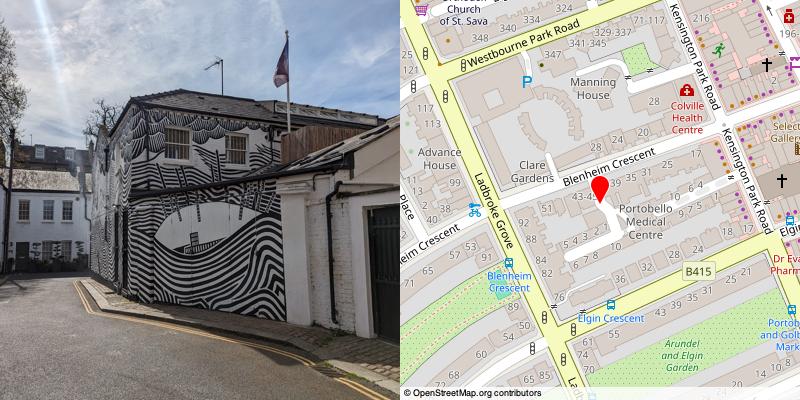
Presumably named after Admiral Codrington, somewhat celebrated for winning a major naval battle against the Ottoman Empire that unfortunately no-one really wanted him to have fought in the first place as the powers that be were quite keen on the Ottoman fleet not being all blown up and that so it could continue to keep the Russians in check.
He also owned slaves (and got compensated when slavery was outlawed) - in 2020 a plaque commemorating him was consequently chipped off the wall of a housing block in Brighton, though it is still called Codrington Mansion, which feels a bit half-arsed as attempts to celebrating historical arseholes go.
No. 1 Codrington Mews is the headquarters of indie label XL Recordings, who have decorated it with artwork from albums by Thom Yorke and The xx for some reason. Maybe one day they’ll rename the mews to The xx Mews, as they don’t seem to have been cancelled yet.
#75 Kensington Park Mews, Kensington and Chelsea, W11
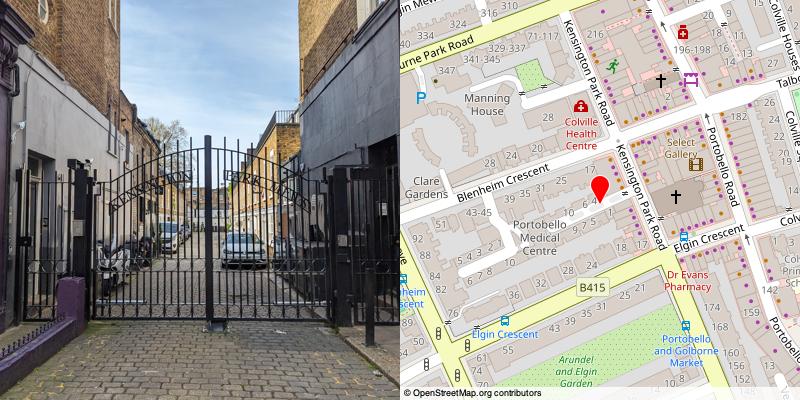
Was due to be obliterated as part of a slum clearance programme - it was reprieved a couple of times as the council were too busy demolishing Kensal New Town, and eventually redeveloped privately in the 1960s. One original property remains, having been transfigured from stable to garage to “conscious” gym, which I assumes means they get mad if you just sit on the exercise bike pedalling along to old episodes of Doctor Who.
The redeveloped version was once home to Gilberto Gil, a Brazilian musician exiled from his own country on the grounds that he had sung a subversive parody of the national anthem “in an obscene manner”.
#76 Dunworth Mews, Kensington and Chelsea, W11
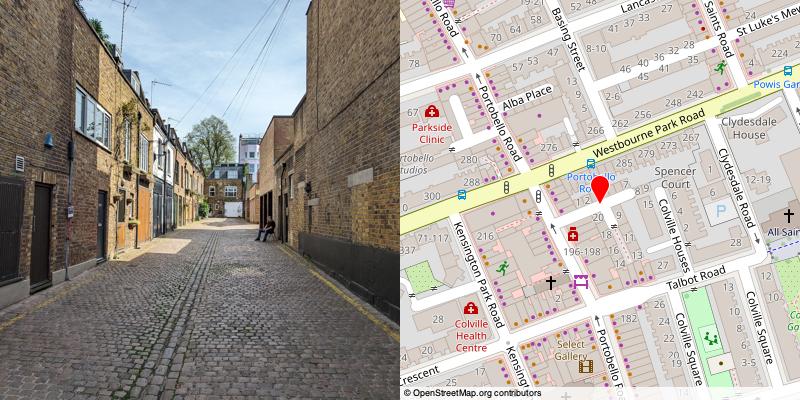
Appears in a self-published novel called Focus in which “While attending the Henley Royal Regatta in England, Samantha Norquist, an American photojournalist, inadvertently overhears three men plotting to illicitly ship weapons to the Congo.”
Samantha is given a flat to live in on the Mews while she covers this exciting story, although the author gets confused about whether it’s called Dunworth Lane or Dunworth Mews and has it as redeveloped ‘elegant pied-à-terres’. The book is set in 1960, which seems a little bit early for this - as late as 1976 the mews was declared a ‘housing action area’, indicating that the living standards were not great, to put it mildly.
This is a pathetic Mews-related inaccuracy and the author should send everyone who bought a copy of the book a handwritten letter of apology.
#77 Tavistock Mews, Kensington and Chelsea, W11
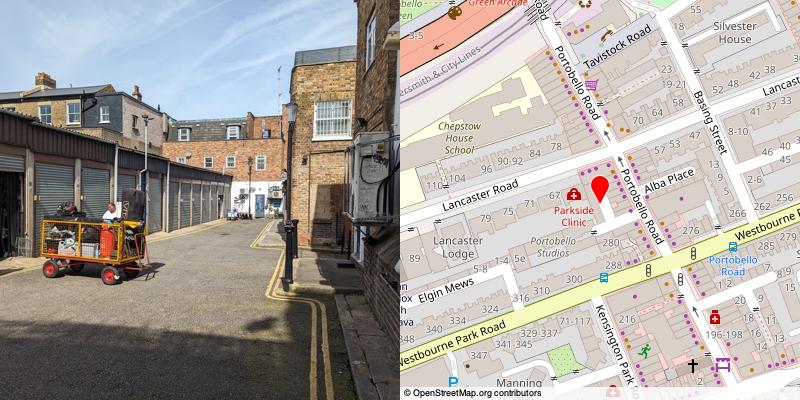
In 1915 an Institute on this Mews hosted the first AGM of the St Quintin’s Park, Kensington and District Fur and Feather society, which organised shows to which people brought rabbits and poultry to be judged according to whatever criteria one judges rabbits and poultry. At the AGM they established a subcommittee to supervise “the strengthening of the poultry section”. This is the sort of thing people had to do in the spare time before they invented telly I guess.
#78 Golden Cross Mews, Kensington and Chelsea, W11

Has at some points been called simply Golden Mews - it was named for the Golden Cross pub on the opposite corner, which has subsequently regenerated into a few new identities, the latest of which is a Japanese restaurant.
The Mews spent much of the 20th century as different sorts of garage, before being converted into housing in 1997. Supposedly the ground floor of each property was designed for use as light industry or office space, but when I nipped behind someone coming out of the gate to have a look it wasn’t very clear if this was still true. Also the gate locked behind me and I couldn’t work out how to open it again, which wasn’t ideal. I did manage to get out in the end though. I’m not still there hiding in a corner.
#79 Norfolk Mews, Kensington and Chelsea, W10

Essentially just a tiny car park with a small row of houses on one side, pressed up against the Westway. For some reason entrance/exit merits a small set of traffic lights, though they weren’t turned on. I walked out regardless and am still alive.
#80 St Lukes Mews, Kensington and Chelsea, W11

There were lots of people taking photos of each other outside one of the houses - my initial assumption was they’d just picked any one of the fairly pretty houses on the street to take “Instagrams” in front of but it turns out that house in particular is famous from being in the film ‘Love Actually’. It’s where Egg from This Life stands outside the front door holding his creepy signs up for Keira Knightley to read because he’s really normal and that’s a normal thing to do.
To be fair they could have instead been taking photos of themselves outside the house a bit further down where Paula Yates accidentally took a fatal heroin overdose, so swings and roundabouts.
Total mewses visited: 70/2380
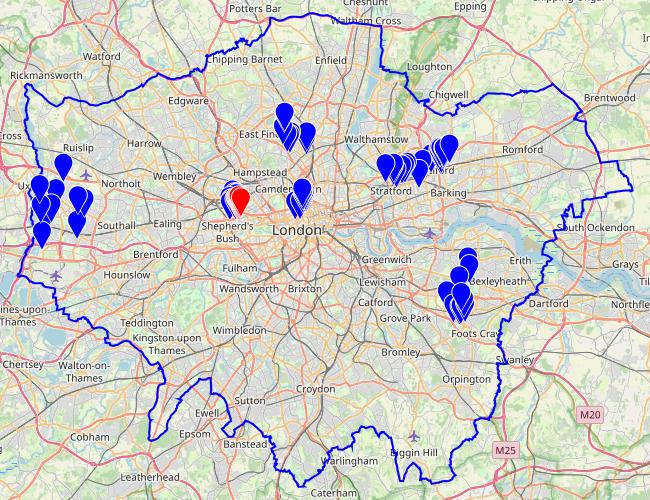
I have just remembered that some people from the stables came into the pub on my first day and thought it was hilarious to try and order e.g. ‘a Guinness shandy’, so I might ring up the RSPCA and make an anonymous complaint that they interfere with the horses. ↩
Some sources put the figure at 200, but there are over 100 police horses alone so that must be too low when you include all the ones in city farms, private stables, those military horses that keep going mental and escaping, etc. ↩
Albeit that this wasn’t in the event as drastic as it could have been if the car shaggers of the 1960s had got to build the massive Ringway system. ↩
On in the case of some ULEZ cameras, with a chainsaw. ↩
Add a comment: